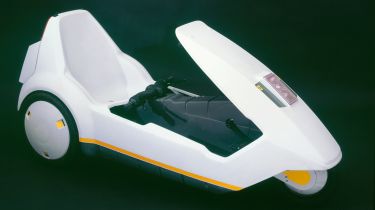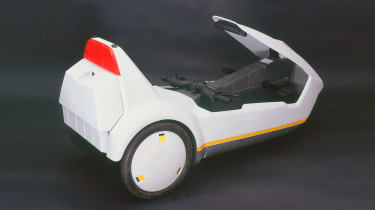Sir Clive Sinclair’s electric runabout was a spectacular failure, but the C5 was ahead of his time
The Sinclair C5 arrived in 1985 with a level of accompanying hype that would surely have impressed a then fourteen-year-old Elon Musk, but this brainchild of one of Britain’s most famous tech entrepreneurs crashed spectacularly soon after launch.
Sir Clive, whose death at the age of 81 was announced on 16 Sept 2021, was lauded in the 1980s as the inventor of the first pocket calculator and the ground-breaking ZX81 and ZX Spectrum home computers. The tech tycoon had a deep interest in electric transport and founded Sinclair Vehicles in 1983 on the back of his earlier commercial successes.
The cheapest electric cars on sale
The company’s first and only production vehicle was the Sinclair C5, an innovative three-wheeler with a polypropylene body designed by Lotus, manufactured at the Hoover washing machine factory in Merthyr Tidfil. The C5 was launched with great fanfare in January 1985 in London – and the project went downhill from there.
Powered by a 12-volt lead acid battery, the C5 had a claimed range of 20 miles – enough to cover many people’s commutes to work – but it could only travel at 15mph. It’s other disadvantages were a lack of any form of weatherproofing, while the C5’s low build and recumbent driving position left drivers feeling exposed and vulnerable in traffic.
In order to overcome range anxiety – a term which hadn’t been coined at the time – the C5 came with pedals, while its handlebar steering also pointed to its purpose. Sinclair proposed the C5 as a compromise between a car and a bicycle, but the concept proved to be unappealing to both sets of users.
Ultimately, instead of helping to reshape Britain’s motoring landscape, the C5 was pilloried in the media and became something of a national joke. Reviewers and safety organisations slated the low-slung EV as dangerous, and it was lampooned for a series of perceived failings, including the fact that a lack of reverse gear meant you had to get out and lift the nose around if you wanted to get out of a tight spot.
While Sinclair optimistically planned for a series of EVs including larger spin-off versions of the C5 capable of up to 80mph, the writing was on the wall. Within months of the C5’s launch production was halted and retailer Comet was trying to flog-off unsold C5s for £139.99 – a huge discount on the original £400 asking price. Sinclair Vehicles went bust the same year.
Nowadays only collectors and historians take much interest in the Sinclair C5, but the vehicle and it’s far-sighted inventor Sir Clive are a significant chapter in the rapidly developing history of electric vehicles..
Looking at getting your own cheap electric transport? Check out our best electric scooters list here…
Source: Read Full Article


 The cheapest electric cars on sale
The cheapest electric cars on sale